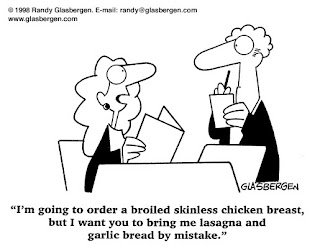When we’re on a diet, it is so important to use our calories wisely simply because we are not allowed that many. The word "wisely" what creates a bit of confusion among
dieters, though. At the beginning of every diet, we are only worried about calories. Then, we hear that we have to watch our fat intake. And, to make things worse, we hear all this bag things about carbs and sugar. The truth is that we sometimes don’t know how to make all this information work to our advantage. I mean, even some information contradicts itself. How are we supposed to make sense of it all, then? I thought a good way to address all this crazy confusion would to look at those nutrition facts labels. You’d be amazed just at how much information these tiny labels contain. In fact, they contain so much information that I will break this mini-tutorial on nutrition facts labels into 10 parts. Yes, you read that right: 10 parts! That's how loaded these labels are with information that can be quite useful to us. Also, I figured that writing a 10-page post would be quite boring to read. Anyway, let’s get started.

As you can see at your left, there’s the nutrition facts label of the
banana smoothie I usually have for breakfast. I figured this was a good example since it has a bit of everything. So, the first thing you want to look at is the serving size at the top of the label. Always make sure to look at the serving size – especially when reading the label on a diet food. Often times, they advertise the product as having only 100 calories but they don’t tell you that the serving size is super small. Thus, when comparing a diet food with its regular version, look at the serving size to see if it is really has fewer calories than the diet option.
The amount of calories in the stated serving size is the first piece of information that you’ll find on the label. Knowing the amount of calories, will help you budget your calories for the day. By now, you hopefully know how many calories you need a day. If not, click
here.
Now, getting to the good stuff:
fat! There has been so much bad press about fat that most of us are terrified of fat, right? Well, although a high fat intake can negatively impact your health, our body still needs it in moderate amounts. The general recommendation is:
have 30% of your calories from fat and no more than 10% of your calories from saturated fat. So, if you look at the nutrition facts label, you can see that 1% right next to it. But, what does that one percent mean? The nutritional label is adapted for a person consuming 2000 calories a day. So, here’s how they calculated that 1% of the daily value:
1. 30% of 2000 is 600. This means that you could have 600 calories coming from fat if you were on a 2000-calorie diet.
2. We know that 1 gram of fat is equal to 9 calories. So, let’s convert those 600 calories into grams of fat: 600/9 = 66 grams of fat
3. Then, 66 grams of fat is 100% of the daily value or daily intake. Thus, 1 gram of fat would be around 1% (= 1*100/66) of the daily value. The label says 1 grams of fat but it might be rounded up or down so you calculation might not always give you exactly the same percentage as on the label but it should be fairly close.
However, keep in mind that if you’re consuming less than 2000 calories a day, this % daily value will be different for you. Unfortunately, you’ll have to do the calculation yourself since nutrition facts labels only consider the standard 2000-calorie diet. For example, I should have no more than 360 (= 1200*0.3) calories from fat which is the same as 40 (360/9) grams of fat since I’m on a 1200-calorie diet. Thus, I would be getting 2% (= 1*100/40) of the daily value of fat with this
smoothie. The calculation for saturated fat is pretty much the same except that you use 10% instead of 30% for step 1.
Some other things you might see under fat (besides saturated fat) could be: monounsaturated fat, polyunsaturated fats and trans fat. Also, some labels might even tell you their omega fatty acid content. However,
omega fatty acids are a very interesting and broad subject that I will address in my
next post since the recommendations are very detailed. For now, just keep these 4 categories (sat, mono, poly and trans) in mind. If you ever find a label that lists the amount of monounsaturated fat and/or polyunsaturated fat, you’ll notice that there will
not be a daily value percentage for these categories. This is because there is not recommendation set for these yet. Ideally, you should be getting all you 30% of calories from fat in the form of monounsaturated and/or polyunsaturated fat. This is because mono- and polyunsaturated fats are the “good” fats so there is no limit for the "good" stuff. On the other hand, they put a limit (10%) on saturated fats because they are the “bad” fats. So, when having to choose between saturated and unsaturated fats, try to go with unsaturated fats.
There are many sites that get these daily values for you, but there’s a lot of information behind the calculation that I think is very useful. As they say: knowledge is power.














